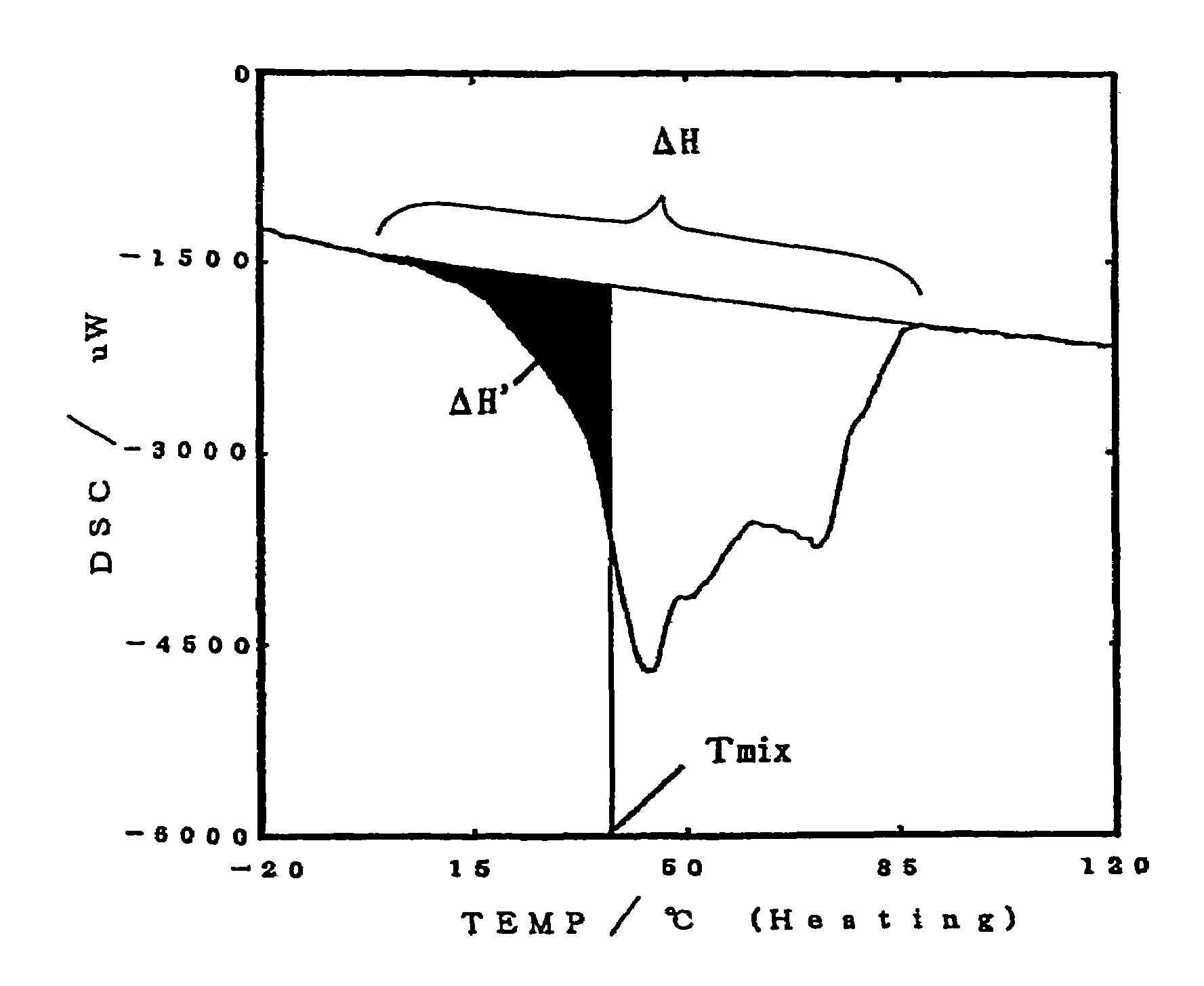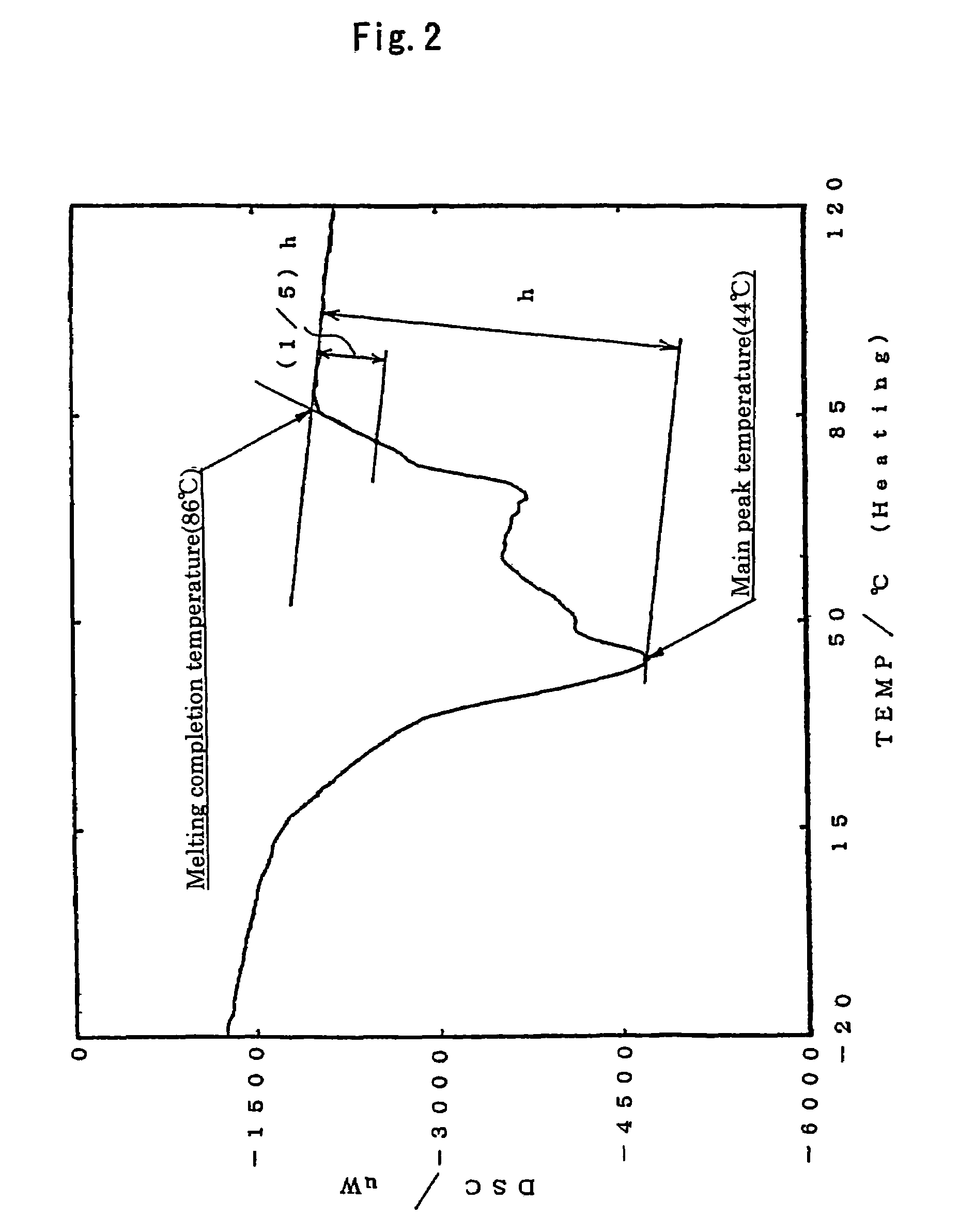Wax composition and method for production thereof
a composition and wax technology, applied in the field of wax composition, can solve the problems of large quantity of solvents, adverse effects on the natural environment and the working environment, and difficulty in uniform dispersing of components,
- Summary
- Abstract
- Description
- Claims
- Application Information
AI Technical Summary
Benefits of technology
Problems solved by technology
Method used
Image
Examples
example 1-1
[0141]In a kneading container of Laboplastomill (30C150 supplied by Toyo Seiki Seisakusho) were charged 44 g of microcrystalline wax (Hi-Mic-1070, available from Nippon Seiro Co., Ltd.; melting completion temperature: 86° C.; main peak temperature: 44° C.) and 11 g of masticated, unvulcanized natural rubber (hereinafter simply referred to as natural rubber) and kneaded at 30 rpm for 10 minutes. The reading on the thermometer set inside the kneading container was 22° C. before charging. All the heaters attached to the kneader were kept off until the end of the kneading. After completion of the kneading, the reading of the thermometer inside the container was 37° C. The ΔH′ at 37° C. was 12% of ΔH. The kneading was carried out without using any solvent.
[0142]The resulting composition looked white with air bubbles and was proved to have the components dispersed uniformly. The composition was deaerated in a nitrogen stream in a dryer at 110° C. and −500 mmHg. The composition was again c...
example 1-2
[0143]A wax composition was obtained in the same manner as in Example 1-1, except for replacing natural rubber with isoprene rubber (Nipol-IR2200, available from Zeon Corp.). At the end of the kneading, the reading of the thermometer inside the kneading container was 39° C. ΔH′ at 39° C. was 16% of ΔH. After the kneading (during which the heaters were kept off), the heater of the kneading container was turned on to raise the inside temperature to 85° C., at which the mixture was further kneaded for 7.5 minutes. The disperse state of the resulting composition in its molten state was observed. It was found that the composition had been deaerated by the kneading at 85° C. and became a clear uniform composition. The presence of non-dispersed isoprene was not observed.
example 1-3
[0144]A pressure kneader (DS 0.3-3, supplied by Moriyama Manufacturing Co., Ltd.) was used. Into the kneading container of the pressure kneader were put 1800 g of microcrystalline wax (Hi-Mic-1070, available from Nippon Seiro Co., Ltd.) and 600 g of isoprene rubber (Nipol-IR2200 from Zeon Corp.) and kneaded at 20 rpm for 5 minutes. To the mixture was added an additional 600 g portion of the same wax, followed by kneading for 10 minutes. The kneading was performed while passing cooling water at 10° C. around the mixing container and the rotor, with all the heaters turned off. The highest temperature the mixture reached during kneading was 37° C. (the reading on the thermometer set inside the kneading container). The temperature of the composition after the end of the kneading was 36° to 42° C. as measured with a contact thermometer. The ΔH′ at 36° C. and 42° C. were 10% and 22%, respectively, of the ΔH.
[0145]The resulting composition looked white with air bubbles and was proved to ha...
PUM
| Property | Measurement | Unit |
|---|---|---|
| melting point | aaaaa | aaaaa |
| RH | aaaaa | aaaaa |
| temperature | aaaaa | aaaaa |
Abstract
Description
Claims
Application Information
 Login to View More
Login to View More - R&D
- Intellectual Property
- Life Sciences
- Materials
- Tech Scout
- Unparalleled Data Quality
- Higher Quality Content
- 60% Fewer Hallucinations
Browse by: Latest US Patents, China's latest patents, Technical Efficacy Thesaurus, Application Domain, Technology Topic, Popular Technical Reports.
© 2025 PatSnap. All rights reserved.Legal|Privacy policy|Modern Slavery Act Transparency Statement|Sitemap|About US| Contact US: help@patsnap.com



